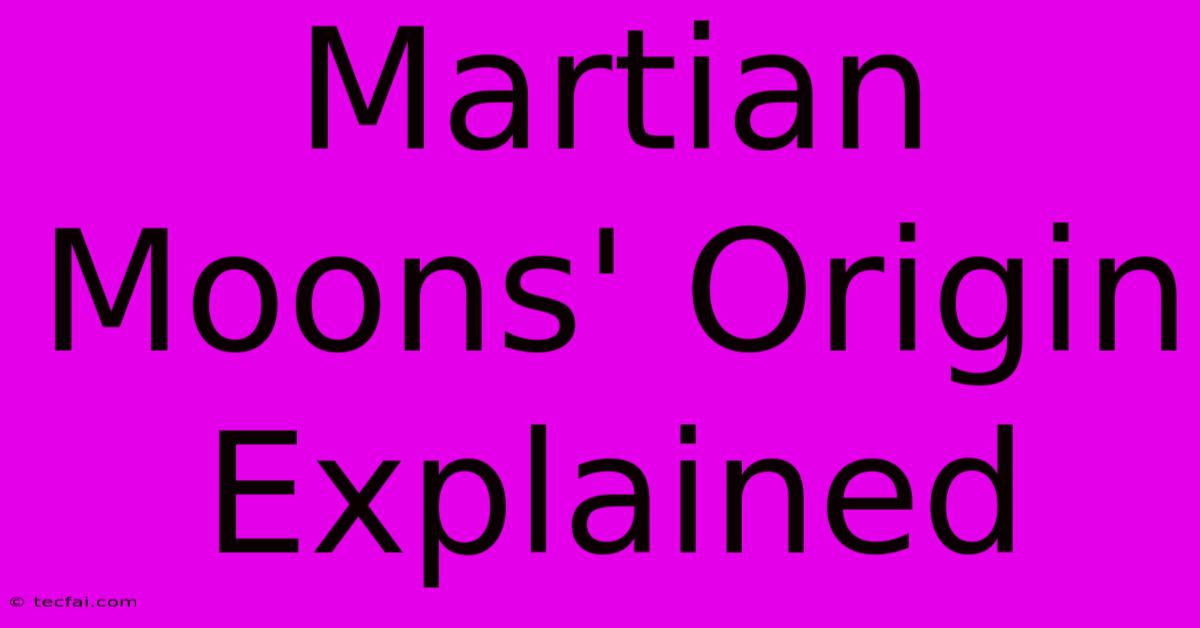Martian Moons' Origin Explained

Discover more detailed and exciting information on our website. Click the link below to start your adventure: Visit Best Website tecfai.com. Don't miss out!
Table of Contents
Martian Moons' Origin Explained: Captured Asteroids or Violent Beginnings?
The two Martian moons, Phobos and Deimos, are small, irregularly shaped bodies that orbit relatively close to Mars. Their origin has been a topic of considerable debate among planetary scientists for decades, with two leading hypotheses vying for prominence: the capture hypothesis and the giant-impact hypothesis. This article delves into these theories, exploring the evidence and the ongoing research that continues to shape our understanding of these fascinating celestial neighbors.
The Capture Hypothesis: Asteroids Trapped by Mars' Gravity
The most widely accepted theory suggests that Phobos and Deimos are captured asteroids. This hypothesis posits that these objects, originating from the asteroid belt between Mars and Jupiter, were gravitationally captured by Mars during its early formation or sometime thereafter.
Several factors support this idea:
- Their Irregular Shapes: Unlike many moons formed alongside their planets, Phobos and Deimos lack the spherical shape typical of large, gravitationally-rounded bodies. Their irregular forms are more characteristic of asteroids.
- Their Composition: Spectral analysis suggests that both moons have a composition similar to D-type asteroids, a common type found in the outer asteroid belt. This compositional similarity lends credence to the capture theory.
- Their Orbits: While not perfectly circular, their orbits are relatively stable and consistent with a captured object's gradual orbital adjustment.
However, this hypothesis isn't without its challenges. Capturing an asteroid requires a specific set of circumstances, including the right speed and trajectory for the asteroid to be slowed down enough to become bound to Mars' gravity. The probability of this event occurring, especially for two objects, is relatively low, leading scientists to explore alternative explanations.
The Giant-Impact Hypothesis: Debris from a Catastrophic Collision
An alternative theory proposes that Phobos and Deimos formed from the debris of a massive impact on early Mars. Similar to the giant-impact theory for the formation of Earth's Moon, this scenario suggests that a large planetesimal collided with Mars, ejecting vast quantities of material into orbit. This debris then coalesced over time to form Phobos and Deimos.
Arguments supporting this theory include:
- The Low Density of the Moons: Phobos and Deimos have relatively low densities, which could be explained by their formation from less dense debris.
- Orbital Characteristics: While their current orbits are not perfectly explained by this hypothesis, simulations suggest that the gravitational interactions within the early Martian system could have shaped their orbits into their current state.
Ongoing Research and Unanswered Questions
Despite the considerable progress made in understanding the Martian moons, significant questions remain. Future missions, including sample-return missions, are crucial for obtaining more detailed information about their composition and internal structure. This data will be vital for distinguishing between the capture and giant-impact hypotheses and refining our understanding of their formation. High-resolution imaging and spectroscopic analysis of Phobos and Deimos will help scientists further scrutinize their surface features, looking for clues embedded within their very structure.
The Debate Continues: While the capture hypothesis remains the leading contender, the giant-impact hypothesis cannot be entirely dismissed. It is possible that a combination of both scenarios played a role in the formation of these intriguing Martian satellites. Ongoing research, coupled with future missions to Mars, will undoubtedly shed more light on this enduring planetary mystery. The ongoing exploration of Mars and its moons promises exciting discoveries that will refine our knowledge of the solar system's early history and the processes that shaped the planets we see today.

Thank you for visiting our website wich cover about Martian Moons' Origin Explained. We hope the information provided has been useful to you. Feel free to contact us if you have any questions or need further assistance. See you next time and dont miss to bookmark.
Featured Posts
-
J K Dobbins Exits Game With Knee Injury
Nov 26, 2024
-
13 Year Old Indian Prodigy Joins Ipl
Nov 26, 2024
-
Mavericks Vs Heat Buod Ng Laro Nov 24 2024
Nov 26, 2024
-
Thanksgiving Winter Storm Warning
Nov 26, 2024
-
Religious Opposition To Uk Euthanasia Bill
Nov 26, 2024
